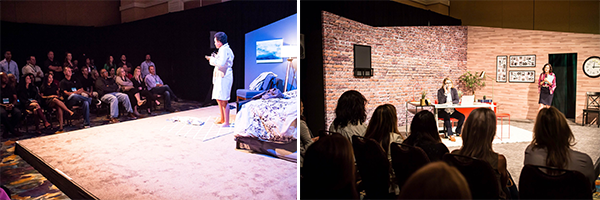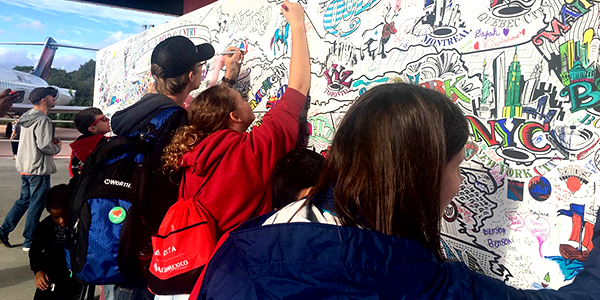2020 trends in corporate events
Jan 20, 2020
Written by: Trey Altemose, Vice President of Creative Services and Paul Bergeron, Sr. Vice President of Event Solutions
(View Author Bio)
Each new year is a great opportunity to start fresh and revisit your approach to corporate event planning. Make it fresh and memorable by incorporating these trends.
Scroll Down
Looking for a way to inspire and engage your audience with unforgettable corporate events and experiences? It’s a whole new year – make that a new decade – which means it’s a great opportunity to start fresh and revisit your approach to corporate event planning.
No matter what type of corporate event you’re planning, make it fresh and memorable by incorporating these trends.
- Immersive Experiences
Immersing an audience into a message is a powerful way to create excitement and enhance learning. Picture a pharmaceutical company whose leaders want the audience (their reps) to feel empathy for their patients. They might immerse them in the patient’s daily world, showcasing how a disease impacts even the simplest tasks. Inspirational. Emotional. Memorable. This is how you get a message across.
- Wellness
Your very best efforts will fall flat if you can’t command the focus and total engagement of each attendee – but that doesn’t mean shouting your message from the rooftops. Instead, consider facilitating engagement by creating a space where participants want to be – where their needs are met and they feel welcomed, focused and well. There are a number of easy ways to encourage mindfulness and wellness throughout an event, such as thoughtful planning of menus to keep participants alert and energized, and scheduling meditation moments to refresh. We’re all connected to our devices constantly so you might also consider providing wellness zones to unplug where phones are a no-go and the only thing recharging is the people. - Mixed Reality
Mixed reality is a new corporate event production technique that blurs the lines between live action, animation, stage depth and scenic. Think: an executive becoming part of their presentation, not simply presenting with images behind them. Imagine they have the ability to set off animated graphics with their movement that support their messages. It’s visually exciting and unexpected. - Holoporting
While holograms were considered edgy and cool when they first became popular, companies quickly realized that they were also very expensive. Now the technology has been tamed to “holoport” a person or product live into a meeting for an affordable price. This increases the level of engagement and techno-cool factor for any meeting or corporate event. Have a CEO who wants to be onstage but can’t take the time to travel there? They can beam onto a stage by using a simple green screen setup in their office, allowing them to be present at the event and even have a live conversation with the audience. Multiple presenters can be beamed in at once – all live – to engage in panel discussions or add creative elements. - Sustainability
The footprint of an event can have a significant impact on our planet. As event planners, it’s our job to be mindful of what we can do to reduce the carbon footprint of events we produce. What can we measure and improve on? Can we have participants walk or combine transportation methods? Are we clear on our recycling methods? Are we holding our venues and events partners to a true sustainable approach? Sustainability is an increasing part of the conversation and will drive event-planning decisions in 2020 and beyond. - Influencers and Industry Leaders
The trend of bringing in big names to an event is nothing new – but where those names come from has evolved. In today’s rich digital/social environment, the scope and variety has grown exponentially. Think: YouTube stars, celebrity experts, trendsetters, celebrity CEO/CMOs. Relevant influencers and industry leaders bring name recognition, expertise and often, a large following. The key word is relevant – make sure the person you rely on aligns with your audience. Done well, blending influencers and leaders in a live setting with social/digital follow up magnifies the effectiveness of message. - Event Technologist
Technology is present in every aspect of an event, from pre-event communications to on-site registration and on-the-stage lighting and music. To make sure technology is incorporated in just the right spots, consider using a dedicated event technologist. These experts help ensure that the planning and execution of technology is tied to the overall objectives and positioning of the event. A great event technologist should excel in problem solving, data collection and insight from analysis. They can also offer ideas on how to amp up the attendee experience, like using gamification or different apps to engage participants throughout the event. - Target your audience
While it’s trendy to evoke studies and analysis of Millennial behavior, the most important thing is to know and cater to your specific audience. And of course, that starts with knowing the demographic and psychographic composition of your event audience. Fortunately, there are more audience-targeting tools and resources available to event planners than ever before – with ever-increasing immediacy and ease of use.
- Safety and Security
Prioritizing safety and security has always been a part of the event industry but there are new trends emerging to help make attendees feel comfortable whether they’re at a meeting down the street or halfway around the world:
- Require your on-site event staff to participate in ongoing training and certifications such as CPR, crisis management and active shooter. There is also a push underway by event planners around the world to create a standard security certification. It would cover things like health and safety, risk management and event security. (Source: Event Manager Blog)
- Make sure venue evacuation plans are clear and accessible for both event staff and attendees
- Use apps to communicate fast-changing and potentially dangerous situations
Clarifying your plans can help make sure that both you and your attendees can relax and be in the moment.
Let's get started today.













